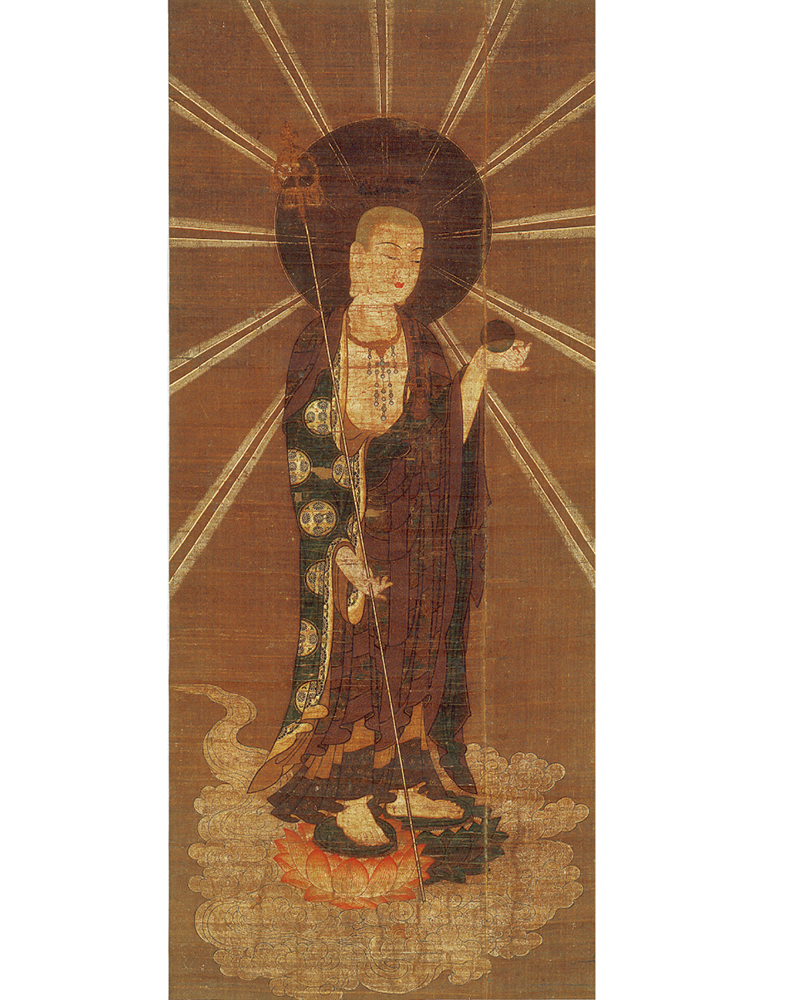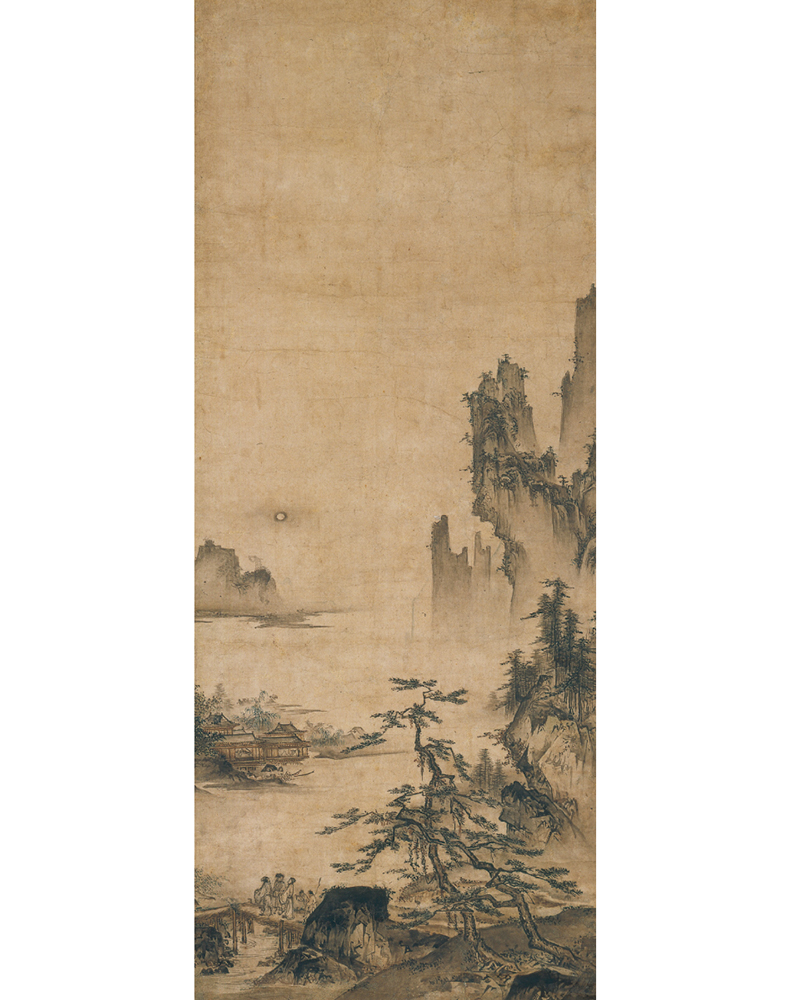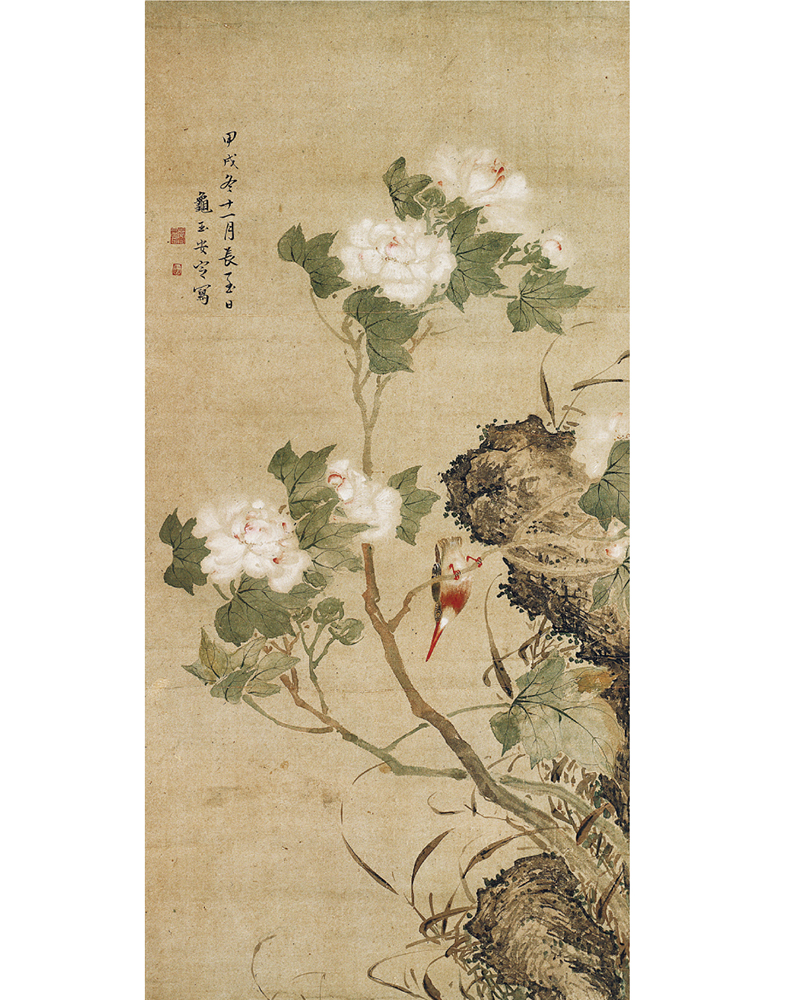Jizo Bodhisattva statue
(Personal guardian elephant)
Country
Japan
Era
Nanbokucho to Muromachi period (14th to 15th century)
Traits
Coloring on silk
Number of members
1 width
Law
103.8cm long x 44.6cm wide
Commentary
It depicts Jizo on a lotus pedestal approaching on a cloud. He holds a jewel in his left hand, a shakujo in his right hand, a yoraku (robe) on his chest, and is wearing a robe. Jizo Bodhisattva was widely worshipped in conjunction with the idea of the end of the world, from the mid-Heian period. This is because Jizo Bodhisattva was believed to save all living beings suffering in the cycle of reincarnation in the six realms, and even those who had fallen into hell. Early Jizo Bodhisattva statues were seated, but gradually more and more were painted standing, and images of him as a solitary deity rapidly increased after the Kamakura period. His step forward expresses the people's fervent hope that he will be saved as soon as possible.
Kasuga Kokuzo Mandala
(Kasuga National Zoo Mandala)
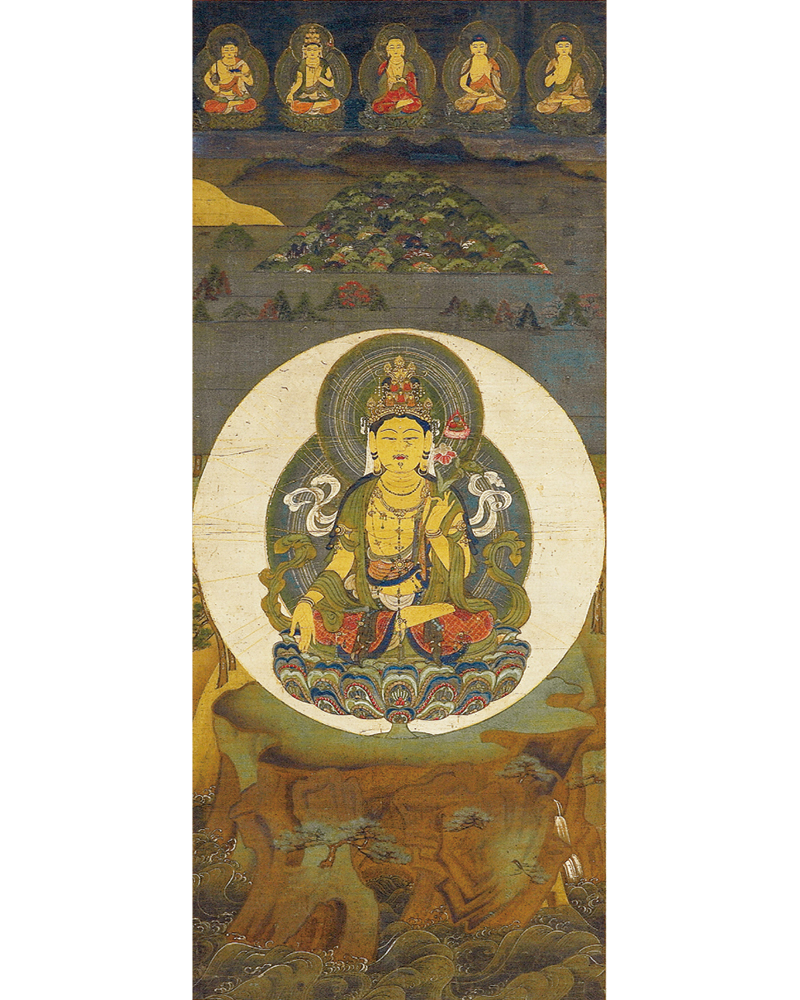
Country
Japan
Era
Kamakura - Nanbokucho period (14th century)
Traits
Coloring on silk
Number of members
1 width
Law
93.2cm long x 39.0cm wide
Commentary
The Buddha in the center of the painting is Gyumonji Kokuzo Bosatsu. He is the principal image of Gyumonjiho, a secret technique for improving memory, and was devoutly worshipped at Kofuku-ji Temple. In the background are other Buddhas from the sacred grounds of Kasuga Shrine, such as Mt. Mifusa and Mt. Kasuga. From the right, they are Shaka Nyorai (Ichinomiya), Yakushi Nyorai (Ninomiya), Jizo Bodhisattva (Sannomiya), Eleven-Headed Kannon (Shinomiya), and Manjusri Bodhisattva (Wakamiya). This is based on the idea that Buddhas are the original form, and gods are temporary forms used to spread teachings to the people, and is known as the Honji Suijaku theory. This theory was born during the Heian period, when Buddhism was combined with ancient Japanese beliefs, but in the Middle Ages, when syncretism of Shinto and Buddhism was widespread, this work shows the idea of believing in Kasuga Taisha and Kofuku-ji as one.
The Lotus Pond Kannon
(Legal Information)
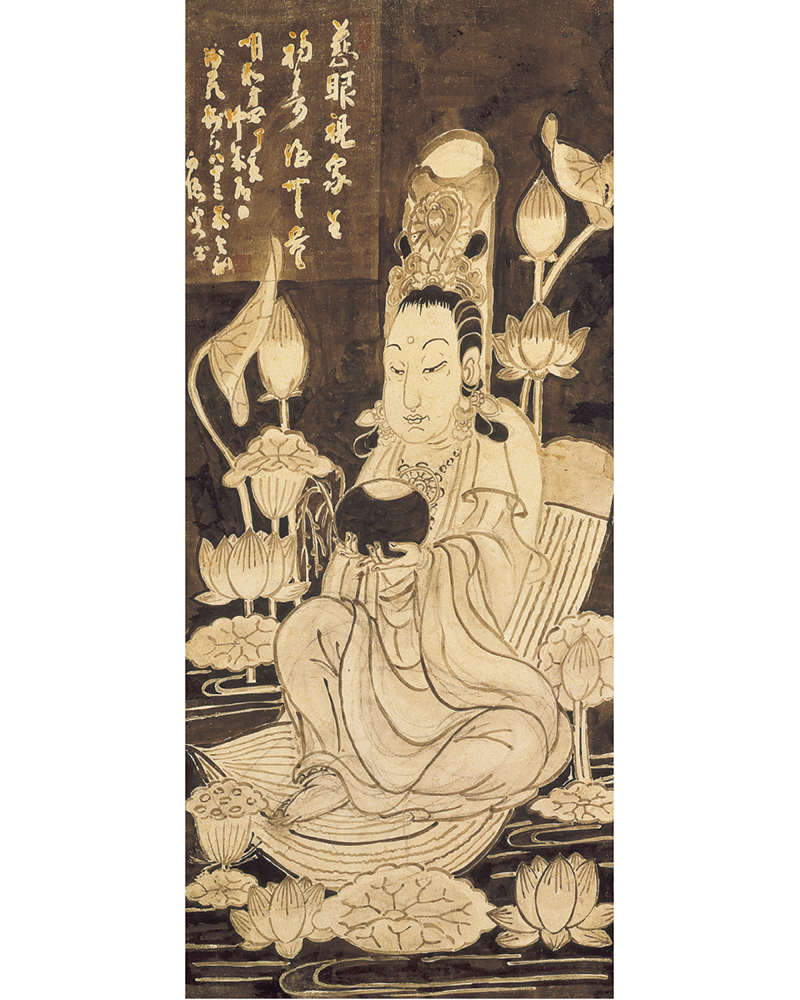
author
Hakuin Ekaku
Years of birth and death
1685-1768
Country
Japan
Era
Edo period, 4th year of Meiwa (1767)
Traits
Ink on paper
Number of members
1 width
Law
133.0 cm long x 56.9 cm wide
Commentary
Hakuin Ekaku was born in Numazuhara. He became the head priest of Numazu Shoinji Temple at the age of 33, and in his later years he opened Ryutakuji Temple in Izu Mishima. He was a man of great virtue, but he wore ink-dyed robes throughout his life. He explained Buddhism in simple terms through his own paintings and calligraphy, and was revered beyond his social status. Hakuin's mother had a deep faith in Kannon. This had a great influence on Hakuin, and he painted many statues of Kannon to teach and guide people. This was created at the age of 83, the year before he passed away. Kannon sits on a lotus leaf with one knee raised. His appearance is generous and full of compassion. He wears a high jeweled crown on his head, a garland on his chest, and holds lapis lazuli (bowls) in both hands, a willow branch attached to his hand, and is wearing a heavenly robe. The background is all ink, but it is reminiscent of rich colors. It is likened to a lotus blooming pure flowers from a muddy pond, and represents that Kannon will save those who are suffering in this chaotic world.
Landscape
(Sansuizu)
Specific information
Important Art Objects
author
Gakuo Zokyu
Years of birth and death
? ~1486~1514~?
Country
Japan
Era
Muromachi period (15th-16th centuries)
Traits
Ink and wash on paper
Number of members
1 width
Law
Length 79.4 cm x Width 32.0 cm
Commentary
The moon floats in the sky and a high, sharp peak rises to the right. A tower can be seen on the left, amid a landscape of a large river or inlet. In the foreground, an old pine tree and five figures crossing a bridge. Ink-wash landscape paintings were mainly created by Zen Buddhist artist-monks as part of their training, and Gakuo was a master of this style. Gakuo Zokyu was a monk-painter during the Muromachi period. His birth and death dates are unknown, but he is thought to have been a disciple of Shubun, a monk-painter who was a pioneer of ink-wash painting in Japan. He created this work when he was around 60 or 70 years old. The moist, warm ink tones and delicate brushstrokes well represent the distinctive features of Gakuo's work.
Spring and Autumn Paintings by Lord Teika
(Teika Shounjuzu)
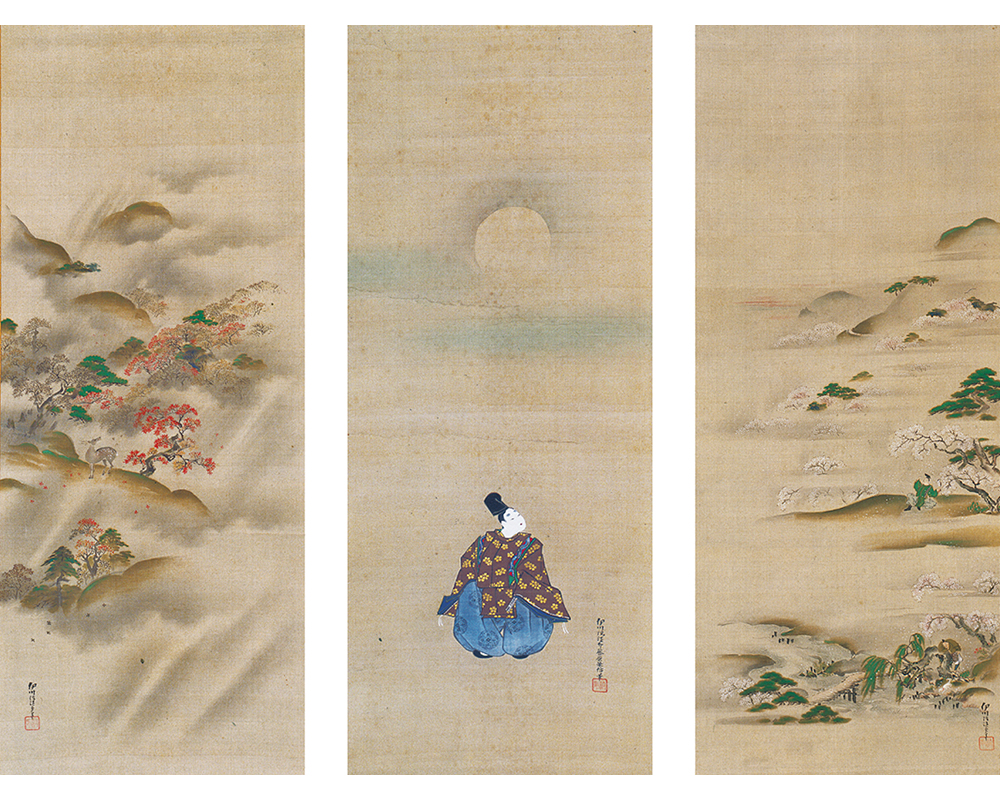
author
Kano Isen'in Naganobu
Years of birth and death
1775-1828
Country
Japan
Era
Edo period (19th century)
Traits
Coloring on silk
Number of members
3 widths
Law
Each: 99.8 cm x 40.8 cm
Commentary
Kano Eishin was born as the son of Yokawain Koreishin, the seventh head of the Kobikicho Kano family, one of the inner palace painters with access to the Edo Shogunate. He succeeded as the eighth head of the family in 1808, and studied Tang and Song dynasty painting, Qing dynasty painting, and ancient Yamato-e painting, and was said to be the most skilled artist in the Kano family. This work was created after he was appointed a Hoin by the Kanki and called himself Ikawain, at the age of 42 in 1816. The middle scroll shows the poet Fujiwara Teika, gazing up at the full moon sky and humming a poem that comes to mind. The right scroll shows a spring scene, where men take a break from falconry to admire the cherry blossoms. The left scroll shows an autumn scene, where the melancholy cries of deer echo through the mountains, shrouded in rain and covered in red leaves. This work is full of lingering emotion and evokes the world of Teika's waka poetry.
Wakaura Amanohashidate
(The young man's back is not a step.)
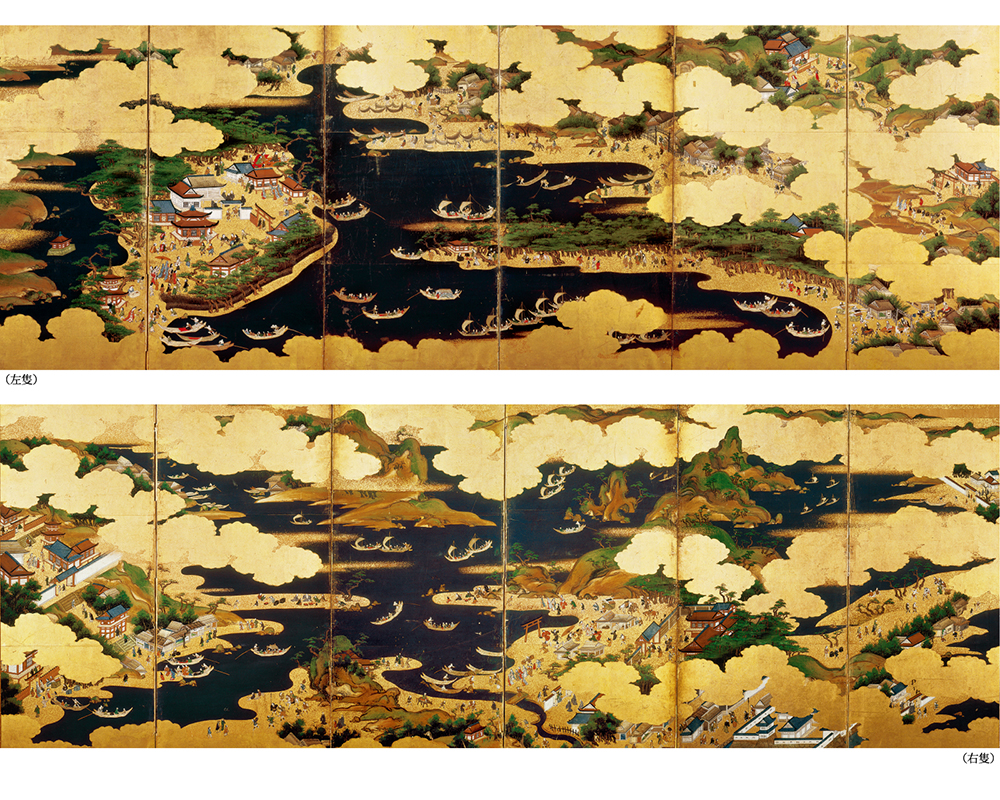
Country
Japan
Era
Edo period (around the 18th century)
Traits
Paper with gold background coloring
Number of members
6 pieces, 1 pair
Law
Each: 92.7cm long x 272.4cm wide
Commentary
This painting combines two famous places that have been the subject of utamakura poetry since ancient times. The left screen shows Amanohashidate in the centre with its green pines and sandbar, with Chion-ji Temple on the opposite shore to the left and Otokoyama Hachiman Shrine on the far right. The right screen shows an inland sea spreading out calmly to the left, with Wakatenjin Shrine or Kishu Toshogu Shrine in the centre, Kimiidera Temple and Tamatsushima Shrine in the middle. Wakayama Castle can also be seen in the lower right. Both screens depict pilgrims to the shrines and temples and the lives of the people who live there against the backdrop of scenic views. Many such famous place folding screens were produced in the early modern period, as touring famous and historical sites, combining pilgrimages to shrines and temples with leisure activities, became popular.
Hibiscus and Cicadas in the River
(Fuyou Kawase-mizu)
author
Kurokawa Kigyoku
Years of birth and death
1732-1756
Country
Japan
Era
Edo period, 4th year of Horeki (1754)
Traits
Light color on paper
Number of members
1 width
Law
85.2cm long x 41.6cm wide
Commentary
Kurokawa Kamedyoku was born in Edo. He studied under the Kano school, and was one of the earliest artists to introduce the richly realistic style of Chinese Qing dynasty painter Shen Nanpin to Edo. He was hailed as a genius, but died at the young age of 25. According to the signature, this work was painted on the winter solstice two years before his death. The hibiscus branch is bending severely, the petals threatening to fall off. The kingfisher clings tightly to the branch, enduring the cold wind. The realistic style is subdued, and the piece is summed up in a simple and austere atmosphere.
Rice planting map
(Tauezu)
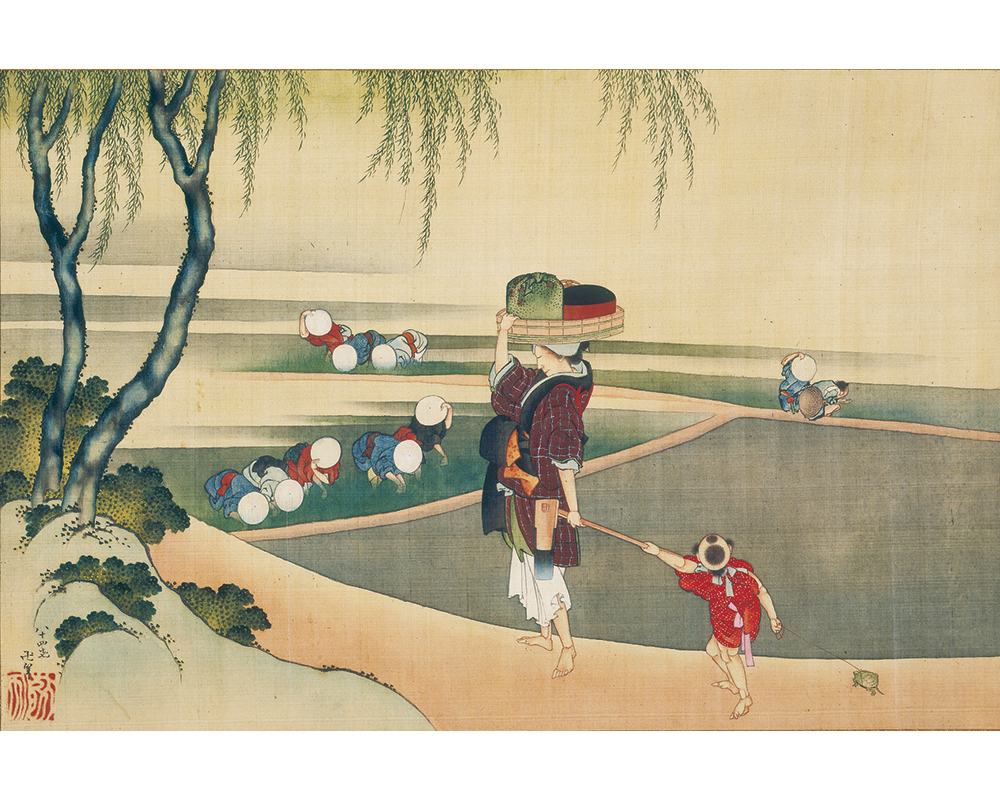
author
Katsushika Hokusai
Years of birth and death
1760–1849
Country
Japan
Era
Edo period, Tempo 14 (1843)
Traits
Coloring on silk
Number of members
1 width
Law
Length 34.2cm x Width 51.5cm
Commentary
Katsushika Hokusai was born in Edo. At the age of 19, he became a disciple of the ukiyo-e artist Katsukawa Shunsho, and drew illustrations for actors and plays. He gradually gained fame as an illustrator of kyoka ehon and reading books, and opened up new horizons in the world of ukiyo-e landscape painting with "Thirty-six Views of Mount Fuji." He was also known as a master of hand-painted paintings.
According to the signature, this painting was created when Hokusai was 84 years old. Under a willow tree, a mother holds a pail containing packed lunches on her head, a child is pulled by the handle of a hoe held by the mother, and a turtle is pulled by the child on a string. If you connect these two together, they form a triangle. In the background, you can see a person planting rice, and the positioning is very rhythmic. This is a work full of wit that is unique to Hokusai.
Clothed Demon
(Black wolf)
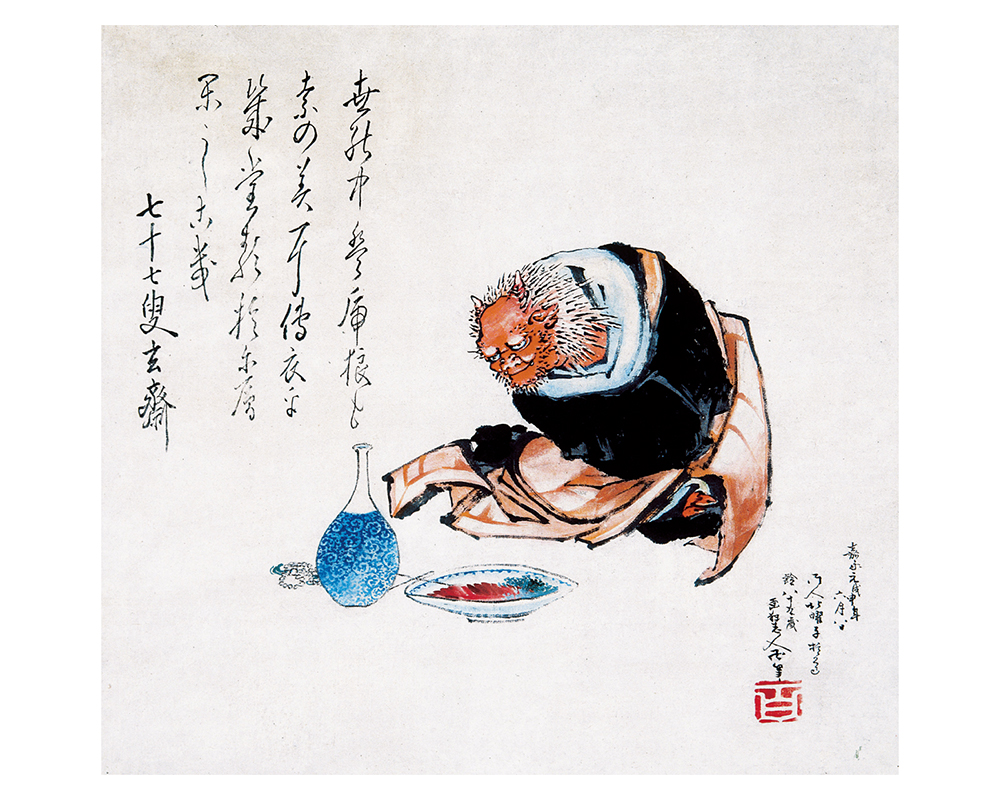
author
Katsushika Hokusai
Years of birth and death
1760–1849
Country
Japan
Era
Edo period, 1848
Traits
Coloring on paper
Number of members
1 width
Law
52.8cm long x 56.2cm wide
Commentary
It depicts a demon dressed in a monk's robe. A red demon in black robes is lost in thought in front of an Imari plate of sashimi and a sake bottle. The demon's sharp, yet somehow enlightened expression seems to speak to the state of mind of Hokusai, a man of madness who raced through the world with the vigor of a fierce tiger, as he faced the end of his life, a man who considered his artistic career to be complete at the age of 100. This was created at the age of 89, the year before Hokusai passed away. The inscription reveals that the painting was done and given to Hokusai's pupil, Homma Hokuyo, a member of the Homma family of Sakata (Yamagata Prefecture). The date of the creation of this work is written in Hokuyo's diary, and the contents of this work match those of the diary. A posthumous tribute from Ikeda Gensai of Yamagata is also included.
Distant view of Mt. Kaimon
(The only thing we can do is to participate)
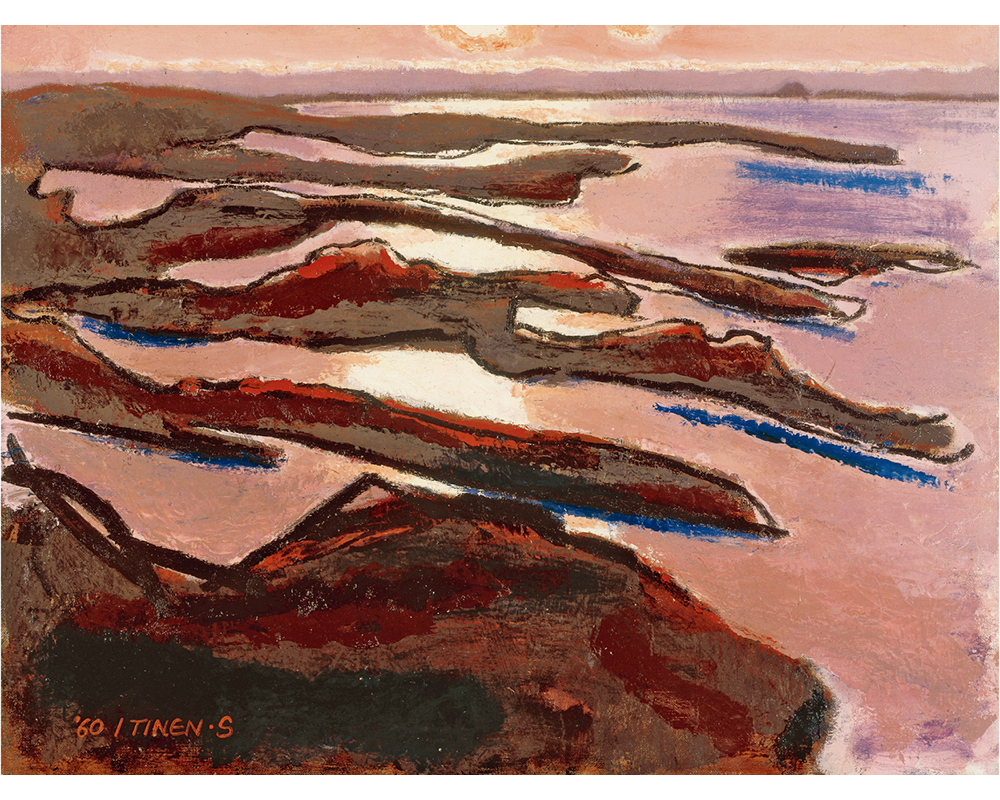
author
Somiya Ichinen
Years of birth and death
1893-1994
Country
Japan
Era
1960 (Showa 35)
Traits
Oil on canvas
Number of members
1st page
Law
59.5cm long x 79.0cm wide
Commentary
Somiya Ichinen was born in Tokyo. He went on to study Western painting at the Tokyo School of Fine Arts (now Tokyo University of the Arts) and was taught by Fujishima Takeji. He belonged to the Nikakai, Dokuritsu Bijutsu Kyokai, and Kokugakai, and painted dynamic depictions of the workings of nature. In 1944, he evacuated to Fuji, Shizuoka Prefecture, and settled in Fujinomiya the following year. After losing his eyesight at the age of 78, he became active in the fields of essays and calligraphy. Kaimon-dake is a mountain on the Satsuma Peninsula in Kagoshima Prefecture. The triangular shaped mountain can be seen in the distance in the upper right corner of the picture, and the setting sun paints the complex, inlet in a beautiful purple. The contrast between the light on the sea surface and the shadow of the inlet is powerful, and gives a sense of the grandeur of nature. Donated by the artist in 1987.
Nap
(Nap)
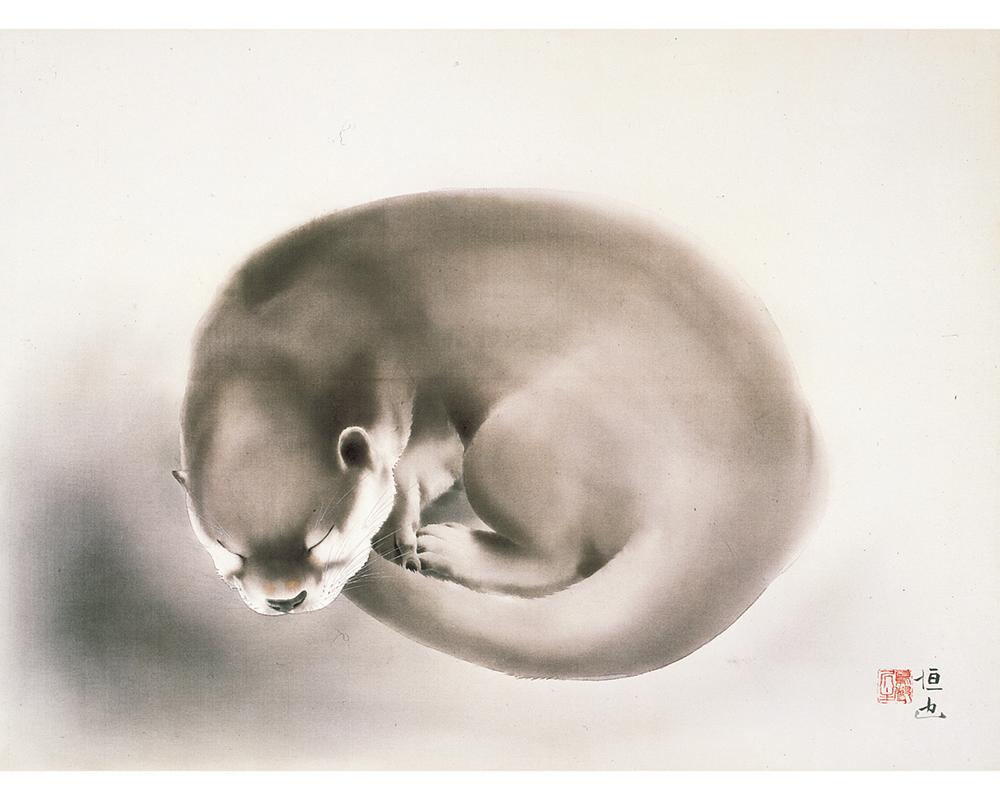
author
Tsuneya Inoue
Years of birth and death
1895-1979
Country
Japan
Era
1971 (Showa 46)
Traits
Ink on Silk
Number of members
1st page
Law
49.5cm long x 59.8cm wide
Commentary
This painting depicts a sleeping Japanese river otter wrapped in its lustrous fur. In 1965, it was designated a special natural monument, but in recent years, its survival has not been confirmed. Inoue Tsuneya was born in Fuji, Shizuoka Prefecture. He studied under Kawai Gyokudo at the Department of Japanese Painting at the Tokyo School of Fine Arts (now Tokyo University of the Arts). He exhibited his works at the Nitten Exhibition before the war, and at solo exhibitions after the war, he made the animals and plants he loved the most his life's subject matter. In his later years, he also worked on protecting rare animals, and at his solo exhibition in 1971, he showed 15 works with the motif of special natural monuments. This work is one of them. The sleeping face of the Japanese river otter shows Tsuneya's deep affection for extinct animals. Donated by Inoue Yukiko in 1984.
Young grass
(Young grass)
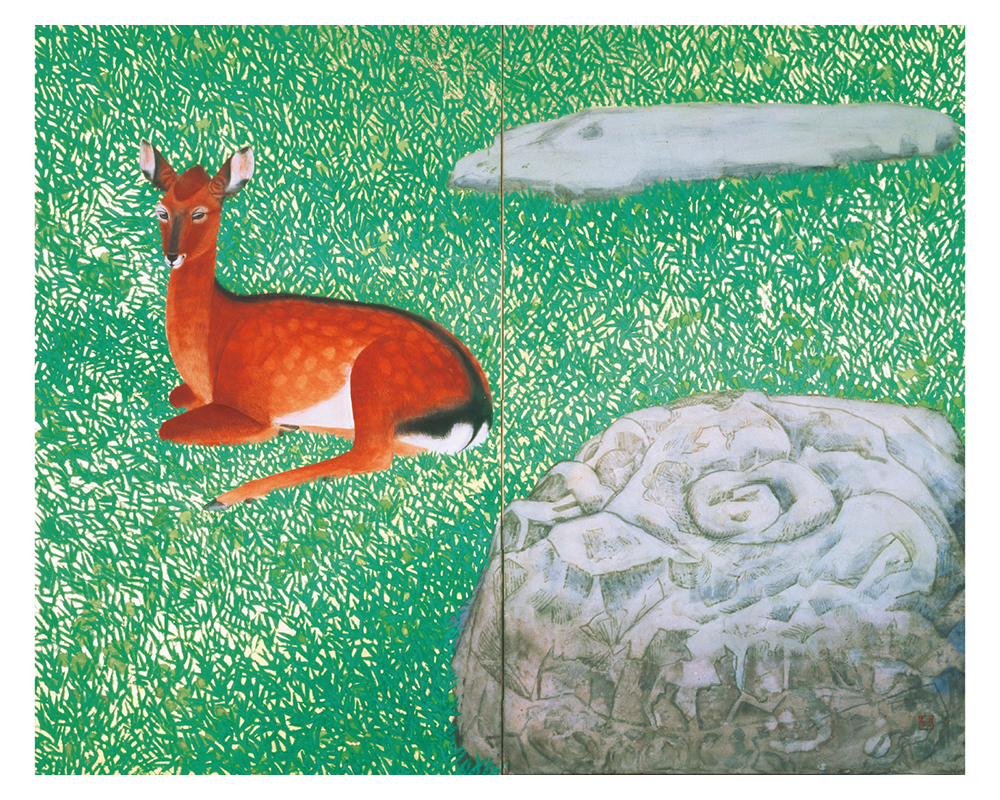
author
Kiyoyuki Nakajima
Years of birth and death
1899-1989
Country
Japan
Era
1978 (Showa 53)
Traits
Coloring on paper
Number of members
2 songs, 1 ship
Law
Length 170.0 cm x Width 214.0 cm
Commentary
Nakajima Kiyoyuki was born in Kyoto. He moved to Yokohama and studied at the Angado Art School of Matsumoto Fuko, a historical painter, while working for a company, and later studied under Yamamura Koka. He became a member of the Japan Art Academy, and with his outstanding descriptive skills and bold imagination, he opened up a unique field of painting in which realism and decorativeness coexist. This work is a folding screen depicting the deer in Nara Park. The sunlight reflecting off the young grass buds is symbolically expressed using gold leaf, a traditional material in Japanese painting. Meanwhile, the deer and foundation stones are captured realistically. This work beautifully demonstrates Kiyoyuki's unique technique of skillfully blending abstraction and figuration. This work was submitted to the 63rd revived Inten Exhibition at the age of 79. Donated by Oda Mieko in 1999.
